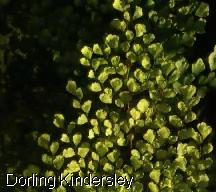Fern

Ferns are considered some of the oldest land plants on earth, dating from 200 million years ago. Ferns are
cryptogamous, or spore-producing, plants. Found worldwide in dark or shady locations, ferns are capable of growing
in soil, on rocks, or on other plants. They range in size from a few centimeters to nearly 24 m (80 ft) in height. The
underground stems and the fronds, or leaves, of some fern plants are edible.
Dorling Kindersley
Fern," Microsoft® Encarta® 96 Encyclopedia. © 1993-1995 Microsoft Corporation. All rights
reserved.
Fossilized Fern from the Carboniferous Period

Paleobotany is the study of fossil plant forms. Although there are far fewer plant fossils than animal fossils, those that
are available have provided useful information concerning the evolution and interrelationships of seeds. Scientists
speculate that the fossil record represents 10 percent or less of all species of plants and animals that have existed in
the geologic past.
Dr. C. R. Belinky/Photo Researchers, Inc.
Fossilized Fern from the Carboniferous Period," Microsoft® Encarta® 96 Encyclopedia. ©
1993-1995 Microsoft Corporation. All rights reserved.
Maidenhair Fern

The maidenhair fern, a deciduous fern common to the temperate regions of Europe and the western hemisphere, has
arching light green fronds borne on black stems. Growing to a height of 30 cm (12 in), the maidenhair fern does best
in shaded locations with moist, slightly acidic or neutral soils.
Dorling Kindersley
Maidenhair Fern," Microsoft® Encarta® 96 Encyclopedia. © 1993-1995 Microsoft
Corporation. All rights reserved.
Soft Shield Fern

The soft shield fern is cultivated for its attractive, soft-textured foliage. This species of fern grows to a height of 60 cm
(24 in). Ferns have become a popular domestic plant, displaying a wide variety of sizes, colors, and textures while
being relatively easy to grow.
Geoff Kidd/Oxford Scientific Films
Soft Shield Fern," Microsoft® Encarta® 96 Encyclopedia. © 1993-1995 Microsoft
Corporation. All rights reserved.
Underside of a Fern Frond Showing Ripe Sporangia

An examination of the underside of a fern frond reveals small, circular spore-bearing structures called sporangia, or
sori. When the sporangia become mature, they split open and release thousands of minute spores. Under favorable
conditions, the spores germinate and grow into a small, heart-shaped plant called a prothallium. The prothallia
produce eggs and sperm, and following fertilization, a new fern plant called the sporophyte begins to grow.
Harold Taylor/Oxford Scientific Films
Underside of a Fern Frond Showing Ripe Sporangia," Microsoft® Encarta® 96
Encyclopedia. © 1993-1995 Microsoft Corporation. All rights reserved.
Back to Plant Index
Design by:
 Pagoda Vista
Pagoda Vista






